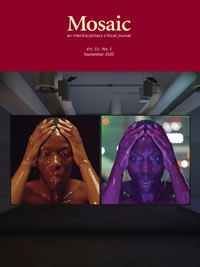Issue 53.3
Overview

General Issue
Published: September 2020
View the issue introduction or see the issue summary and contents below.
9 essays, totalling 176 pages
$24.95 CAD
This general issue features essays by Phillip E. Wegner, whose argument for “fixing the intolerable present” turns on science fiction, and specifically the film adaptation of Uncanny X-Men (1980), X-Men: Days of Future Past (2014); Jill Marsden, who brings us into proximity with irreducibly singular moments in Walt Whitman’s “Song of Myself”; and Fergal Gaynor, who examines the performative dimension to breathing in Samuel Beckett’s How It Is.
How to Fix this Intolerable Present with the Naked Eye; or, Periodizing the ContemporaryPhillip E. Wegner Fredric Jameson’s meditation on periodization highlights some of the challenges involved in any effort to think the contemporary. This essay argues that the best way to narrate the contemporary is through science fiction and further develops this insight through a reading of the comic book series (1980) and film adaptation (2014) of X-Men: Days of Future Past. | |
Poetic Connections: Sympathy and Community in Whitman’s ‘Song of Myself’Jill Marsden If to be sympathetic to others is a prerequisite for harmonious community, how does this function in the absence of identities in common? In his figurations of sympathy as auto-poetic affectivity, Walt Whitman’s “Song of Myself” offers a way, exceeding the humanist register on which much thinking about community relies. | |
Borges on Possible WorldsNahum Brown This essay analyzes the philosophical import of Jorge Luis Borges’s story “The Garden of Forking Paths.” Borges’s story contains rich insights into the nature of possible worlds, contradiction, and infinity. In contrast to Leibniz, who claims that non-contradiction separates infinite possible worlds, Borges’s vision of modal reality does not adhere to non-contradiction. | |
‘When the Panting Stops’: Breath and Breathing in Beckett and How It IsFergal Gaynor The art of Irish writer Samuel Beckett (1906-1989) remains a limit point for prose fiction and theatre, and exerts a strong attraction for contemporary visual art practices. In this essay I consider his work, and the novella How It Is in particular, in terms of a repeated internal motif and central element of performance, “breath.” | |
On Burning Canadian Literature in Amsterdam: In the Afterlives of National LiteraturesRobert Zacharias In 2011, Lawrence Hill’s bestselling novel, The Book of Negroes, was burned by protestors in the Netherlands. This essay considers the controversy surrounding Hill’s novel to explore the international circulation of literature and reflect on the enduring impact of national literatures in our ostensibly globalized present. | |
Aldous Huxley’s Ape and Essence and Oversights in Discourses of NatureMark Taylor This essay considers Aldous Huxley’s Ape and Essence in the light of late 1940s conservationism. The novel shares specific concerns with contemporary conservationist non-fiction, but embeds these within a fragmented, polyvocal novel. Doing so, it demonstrates how different schools of thought clash, each blind to underlying nature in some aspect. | |
Psychology of a Biographical Novel: Narrative Empathy in Poniatowska’s LeonoraAyelet Ishai This essay examines the representation of Surrealist painter and writer Leonora Carrington (1917-2011) in Elena Poniatowska’s biographical novel Leonora. Considered through the lens of interdisciplinary cognitive literary studies, my analysis focuses on the narrative properties which make the novel effective in promoting character identification and reader empathy. | |
The Relational Arrangement of People, Materials, and Nature in Eileen Chang’s Spatial DescriptionXiaohu Jiang Applying Martina Löw’s sociological theory of space, this essay presents an analysis of the relational arrangement of people, man-made objects, and nature in Eileen Chang’s narratives, through which she vividly depicts the external effectuality of objective social goods subjectively perceived by people in a space and combines spatiality with temporality. | |
‘Foul, strange and unnatural’: Poison as a Murder Weapon in English Renaissance DramaPiotr Sadowski Less spectacular than theatrical violence involving bloodshed, stage murder by poison is nonetheless unsettling because of its secretive nature. Perceived in Renaissance England as dishonourable and unmanly, poison was often associated with women as the “weaker” sex, with discriminated minorities such as Jews, and with Machiavellian politics from continental Europe. |